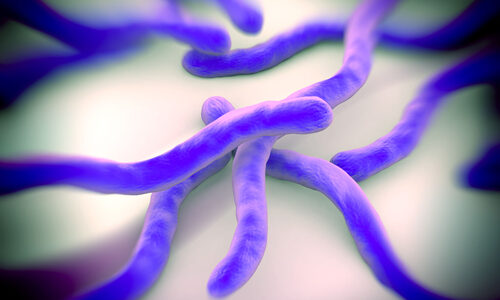Call for your appointment today 914-666-4665 | Mt. Kisco, New York

by Daniel J. Cameron, MD MPH
The Lyme disease bacterium swims in an undulating pattern throughout the body. “The flagella reside within the periplasm, the space between the bacterial cell wall and the outer membrane,” according to Harman, from the Department of Molecular and Cellular Biology, University of Arizona. [1] “Rotation of the flagella within the periplasm causes the waveform to propagate, leading to a traveling wave undulation of the entire body.”
The researchers’ earlier work with mathematical modeling predicted that the shape of a Lyme disease spirochete might affect pathogenesis. “It is likely that the specific shape of B. burgdorferi is important in its ability to infect mammals,” says Harman. “Consequently, altering the shape and/or stiffness of the bacterium could affect pathogenesis.”
Several antibiotics were identified that are known to affect cell wall synthesis. “Although doxycycline acts through inhibition of protein synthesis, amoxicillin and cefuroxime axetil both interfere with cell wall synthesis.” According to Harman, “Disruption of either the cell wall itself or of the proteins that are involved in synthesizing it eventually leads to cell lysis.”

The researchers chose vancomycin to examine the effects of antibiotics on cell wall synthesis. Vancomycin “has previously been shown to be active against B. burgdorferi in vitro” in two studies identified by the authors. [2, 3] The researchers were also able to alter both the shape and speed of the Lyme disease spirochete in vitro.
Vancomycin reduced the swimming speed of the Lyme disease spirochete by about 15% by reducing the cell wall stiffness. Their results allowed the authors to conclude “since motility is crucial to the virulence of B. burgdorferi, the results suggest that sublethal doses of antibiotics could negatively impact spirochete survival by impeding their swim speed, thereby enabling their capture and elimination by phagocytes.” [1]
Their conclusions are based on in vitro laboratory data. It is not clear if findings in the lab can be generalized to humans. Moreover, it is not clear if vancomycin will be studied in humans since the medical community has sought to limit the use of the drug to fight severe infections such as MRSA (methicillin-resistant Staphylococcus aureus) and penicillin-resistant pneumococci. [4]
The investigators at the University of Arizona, Yale University, and University of Bayreuth are to be congratulated on increasing our understanding of the role of Lyme disease spirochete motility.
References:
- Harman MW, Hamby AE, Boltyanskiy R, Belperron AA, Bockenstedt LK, Kress H, Dufresne ER, Wolgemuth CW: Vancomycin Reduces Cell Wall Stiffness and Slows Swim Speed of the Lyme Disease Bacterium. Biophys J 2017, 112(4):746-754.
- Dever LL, Jorgensen JH, Barbour AG: In vitro activity of vancomycin against the spirochete Borrelia burgdorferi. Antimicrob Agents Chemother 1993, 37(5):1115-1121.
- Hunfeld KP, Weigand J, Wichelhaus TA, Kekoukh E, Kraiczy P, Brade V: In vitro activity of mezlocillin, meropenem, aztreonam, vancomycin, teicoplanin, ribostamycin and fusidic acid against Borrelia burgdorferi. Int J Antimicrob Agents 2001, 17(3):203-208.
- Bruniera FR, Ferreira FM, Saviolli LR, Bacci MR, Feder D, da Luz Goncalves Pedreira M, Sorgini Peterlini MA, Azzalis LA, Campos Junqueira VB, Fonseca FL: The use of vancomycin with its therapeutic and adverse effects: a review. Eur Rev Med Pharmacol Sci 2015, 19(4):694-700.




After a camping trip in 1995 I became so ill that the doctors thought that I had MS. An immediate MRI, Spinal Tap and even Lyme Disease Testing was performed with no clear results. All of the specialist had no idea what was wrong. After 13 years of living with every “Lymies” experiences (nightmare), my family doctor treated me for my constant UTI’s/hematuria, intestinal pain, fatigue, feeling ill etc. with various antibiotics. As a consequence, I developed C-Dif. She prescribed Vancomycin. The insurance company would only pay for the liquid, compound form of Vancomycin. I was on a strict every 8 hour schedule with the Vancomycin. Every time I would stop the Vanco I would start feeling worse. I pulse dosed the Vanco. After months of treatment with Vanco, I felt wonderful!!! In fact, I cannot remember EVER feeling so good!!
It only lasted for a few years and then I started to feel ill again and it continues to be a living hell.
Every medical professional that I have told my experience to simply states that Vanco could NOT have cured Lyme Disease or anything else because Vanco only stays in the intestinal tract.
I am so glad to see that someone is interested in researching how Vancomycin can help get rid of Lyme Disease. Based on my experience, I truly believe that Vancomycin will be either be a cure or at least a relief from the symptoms of Lyme Disease.